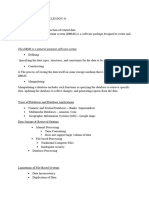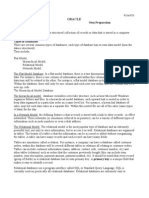DD
DD
Uploaded by
saichanderCopyright:
Available Formats
DD
DD
Uploaded by
saichanderCopyright
Available Formats
Share this document
Did you find this document useful?
Is this content inappropriate?
Copyright:
Available Formats
DD
DD
Uploaded by
saichanderCopyright:
Available Formats
Introduction to Database
Database is a collection of information in a structured way. We can say that it is a collection of a
group of facts and processed information’s. Databases store information in fields, records, and
files. A field is a single piece of information—a customer’s first name, for example. A record is
one complete set of fields—the customer’s first name, last name, address, phone number, and
account information. And a file is a collection of records—a complete list of all customers.
File System
The file system that comes with your computer is a very primitive kind of database management
system. Data are kept in big unstructured named clumps calledfiles. A flat file database is a
database designed around a single table. The flat file design puts all database information in one
table, or list, with fields to represent all parameters. A flat file may contain many fields, often, with
duplicate data that are prone to data corruption. If you decide to merge data between two flat files,
you need to copy and paste relevant information from one file to the other. There is no automation
between flat files.
Database Management System (DBMS)
To use information contained in a database, you need a Database Management System (DBMS), a
collection of software programs that let you to enter, organize, and select information stored in the
database. Each column in a database table contains a different type of attribute and each row
corresponds to a single record. For example, in a table of customers, the columns might include
name, address, phone number, and account information; each row is a separate customer.
The most typical DBMS is a Relational Database Management System (RDBMS). An RDBMS
stores information in tables of rows and columns. The relationships between table data can be
collated, merged and displayed in database forms. Most relational databases offer functionality to
share data across networks over the Internet
DBMS vs. File Systems
Databases management systems (DBMS's -- Oracle, SQL,) have certain features that you can't get
with a flat file.
1.Speed. Modern DBMS's have very advanced routines for getting you data as quickly as
possible.
2.Management of relational entities. DBMS's are good at storing data about multiple,
related entities.
3.Transaction and update guarantees. DBMS's allow you to protect your data -- back it
up, be able to roll back unwanted transactions, ensure that a set of operations on data executes
atomically, etc.
4. Data Security. Database provide different level of securities by having password to access
different level of database which is not provided with file systems
5. Data Administration. You can administrate the values being entered in the database by having
various constraints on the data field. For example, you may allow only numeric fields in salary field.
6. Concurrent Access. Multiple users can access the database at a same time and by using lock
system u can manage the updating of the database on the same field.
7. Crash recovery. In case your database crashes, it has a special mechanism by using you can
recover your database on the last saved state.
Advantages & Disadvantages
Advantages
1.Data independence - application programs are insulated from changes in the way data is structured
and stored which allows dynamic changes and provides growth potential.
2. Efficient data access -
3. Data administration - centralized
4. Data integrity & security -
5. Concurrent access and crash recovery
6. Reduced application development time
Disadvantages
7. Problems associated with centralization
8. Cost of software/hardware and migration
9. Complexity of backup and recovery
In reality, centralized databases are applicable only to small operations. Companies are bought,
sold, and merge often necessitating interaction between distributed databases. An enterprise
database is constructed from the distributed databases.
Components of DBMS
The components of a database system include:
Data:
Database: data that is stored more-or-less permanently in a computer.
Database management system (DBMS): software which allows the user to use or modify
the database.
DBMS Facilities
Data definition language (DDL): used to define the conceptual scheme. The
scheme is compiled and stored in the data dictionary.
Data manipulation language (DML): query sublanguage (retrieval), maintenance
sublanguage (insertion, deletion, modification).
Structure of DBMS
DDL compiler: Compiles conceptual schemes to tables stored in the data dictionary.
Database manager: translates query into file operations
Query Processor:
File manager: often a general purpose file system provided by the operating system.
Disk manager
Telecommunication system
Data files
Data dictionary: structure and usage of data contained in the database.
Access aids: indexes
Users:
Database application programmers: develop programs or interfaces for naive and
online users which are precompiled queries.
Database implementers
Database administrator (DBA): oversee and manage resources
Design of the conceptual and physical schemas
Security and authorization:
Data availability and recovery from failures - backups and repairing damage
due to hardware or software failures or misuse.
Database tuning: performance and database evolution
Database Designers
End users
Casual end users
Naive or parametric end users
Sophisticated end users
Stand-alone users
Data Model
A data models is a collection of concepts that can be used to describe the structure of a database. By
structure of a database we mean the data types relationships and constrains that should hold on the
data. The following are the various types of data models used:
Semantic Data model
Firstly we should be clear on what both terms means:
Semantics – way of linking the entity and the information we have about the data to help us get a
good understanding of the system
Data Model – Data models are made up of:
1) Structures used to create the model (building blocks)
2) Operators we can use on the structures
3) Integrity rules, both explicit and implicit
A Widely used semantic data model is called as the Entity Relationship (ER) model.
Relational Model
TheRelation is the basic element in a relational data model
A relation is subject to the following rules:
1. Relation (file, table) is a two-dimensional table.
2. Attribute (i.e. field or data item) is acolumn in the table.
3. Each column in the table has a unique name within that table.
4. Each column is homogeneous. Thus the entries in any column are all of the same type (e.g.age,
name, employee-number, etc).
5. A Tuples (i.e. record) is a row in the table.
6. The order of the rows and columns is not important.
7. Values of a row all relate to some thing or portion of a thing.
8. Duplicate rows are not allowed (candidate keys are designed to prevent this).
DBMS Architecture
The three levels of the architecture are three different views of the data:
1. Internal - physical or storage view
The internal view is the view about the actual physical storage of data. It tells us what data is
stored in the database and how. At least the following aspects are considered at this level:
Storage allocation. e.g. B-trees, hashing and etc.
Access pathse.g. specification of primary and secondary keys, indexes and pointers and
sequencing.
Miscellaneous e.g. Data compression and encryption techniques, optimization of the internal
structures.
2. Conceptual - community user view
The conceptual view is the information model of the enterprise and contains the view of the
whole enterprise without any concern for the physical implementation. The conceptual view is
the overall community view of the database and it includes all the information that is going to
be represented in the database. The conceptual view is defined by the conceptual schema which
includes definitions of each of the various types of data.
3. External - individual user view
The external level is the view that the individual user of the database has. The same database
may provide a number of different views for different classes of users. In general, the end users
and even the applications programmers are only interested in a subset of the database. For
example, a department head may only be interested in the departmental finances and student
enrolments but not the library information. The librarian would not be expected to have any
interest in the information about academic staff. The payroll office would have no interest in
student enrolments.
Queries
Queries are the primary mechanism for retrieving information from a database and consist of
questions presented to the database in a predefined format. Many database management systems
use the Structured Query Language (SQL) standard query format. SQL is standard computer
language for accessing and manipulating database systems. SQL statements are used to retrieve
and update data in a database. SQL works with database programs like MS Access, DB2, Informix,
MS SQL Server, Oracle, Sybase, etc.
SQL Data Definition Language (DDL)
The Data Definition Language (DDL) part of SQL permits database tables to be created or deleted.
We can also define indexes (keys), specify links between tables, and impose constraints between
database tables.
The most important DDL statements in SQL are:
CREATE TABLE- creates a new database table
ALTER TABLE - alters (changes) a database table
DROP TABLE- deletes a database table
SQL Data Manipulation Language (DML)
SQL (Structured Query Language) is syntax for executing queries. But the SQL language also
includes syntax to update, insert, and delete records. These query and update commands together
form the Data Manipulation Language (DML) part of SQL:
SELECT- extracts data from a database table
UPDATE- updates data in a database table
DELETE- deletes data from a database table
INSERT INTO- inserts new data into a database table
You might also like
- Broken 8th Feel PDFDocument6 pagesBroken 8th Feel PDFarjun100% (2)
- DENR Administrative Order 97-32Document13 pagesDENR Administrative Order 97-32Boo DalupsNo ratings yet
- Whitepaper: Welcome To VINCIDocument34 pagesWhitepaper: Welcome To VINCIandy sanjayaNo ratings yet
- Computer Fundamentals Question Bank Unit-1: Fundamentals of ComputersDocument4 pagesComputer Fundamentals Question Bank Unit-1: Fundamentals of ComputersMr. MANTRA100% (1)
- CSE Database Management SystemDocument23 pagesCSE Database Management SystemAKHIL RAJNo ratings yet
- Introduction To DatabaseDocument6 pagesIntroduction To Databasesimply_cooolNo ratings yet
- Module - 1 DBMS NotesDocument34 pagesModule - 1 DBMS NotesPavan KumarNo ratings yet
- DBMS Complete NotesDocument47 pagesDBMS Complete NotesMeenakshi SaiNo ratings yet
- DbmsDocument36 pagesDbmsMd NasirNo ratings yet
- DatabaseDocument187 pagesDatabasemyny BNo ratings yet
- Database Management Systems - Unit 1 MaterialDocument50 pagesDatabase Management Systems - Unit 1 Materialananthulavarshitha458No ratings yet
- Unit IDocument20 pagesUnit Ipramodkumar64No ratings yet
- Data Base Manageme NT System (DBMS)Document36 pagesData Base Manageme NT System (DBMS)Angelica May BangayanNo ratings yet
- DBMS Unit - 1 FinalDocument89 pagesDBMS Unit - 1 FinalSureshkumar CNo ratings yet
- Database System Concepts and ArchitectureDocument24 pagesDatabase System Concepts and Architecturesubhash_92No ratings yet
- Database Management: Dr. Md. Rakibul Hoque University of DhakaDocument57 pagesDatabase Management: Dr. Md. Rakibul Hoque University of DhakaShahriar HaqueNo ratings yet
- Exp 1Document8 pagesExp 1jasmineNo ratings yet
- De Unit 1Document13 pagesDe Unit 1Sambit SwainNo ratings yet
- Database ss3 WK 4&5Document6 pagesDatabase ss3 WK 4&5solomonchuks19No ratings yet
- Introduction To Database Management System: Poonam MehtaDocument21 pagesIntroduction To Database Management System: Poonam Mehtacyka blyatNo ratings yet
- DBMS NotesDocument11 pagesDBMS NotesbalainsaiNo ratings yet
- Unit I DBMSDocument23 pagesUnit I DBMSpr0075No ratings yet
- Unit - 3 Realtional Database Management SystemDocument35 pagesUnit - 3 Realtional Database Management SystemMiriam JomonNo ratings yet
- Csedatabasemanagementsystemppt-170825044344 DSDSDDocument23 pagesCsedatabasemanagementsystemppt-170825044344 DSDSDRaj KundraNo ratings yet
- Lecture 1-3 (CHP#1)Document38 pagesLecture 1-3 (CHP#1)Huzaifa MemonNo ratings yet
- UNIT I To III Database and Data ProcessingDocument43 pagesUNIT I To III Database and Data ProcessingAnjali MahajanNo ratings yet
- Unit 1: Data Base Management SystemDocument22 pagesUnit 1: Data Base Management SystemRajat SharmaNo ratings yet
- Database Management Systems (3:0:0) : Sub Code: 21IS4C04Document111 pagesDatabase Management Systems (3:0:0) : Sub Code: 21IS4C04EAKEHEH HNo ratings yet
- Database Management System XDocument10 pagesDatabase Management System XVivek KumarNo ratings yet
- Module - 1-NotesDocument34 pagesModule - 1-Noteskurra trivedh sai 222010301036No ratings yet
- Unit 1Document39 pagesUnit 1Vaibhav ArageNo ratings yet
- 2.1. What Is Database Management System?: Database, Contains Information Relevant To An EnterpriseDocument14 pages2.1. What Is Database Management System?: Database, Contains Information Relevant To An Enterprisesumon refatNo ratings yet
- 21aim45a Dbms Module 1Document116 pages21aim45a Dbms Module 1pushpanathan0704No ratings yet
- Im Answer SheetDocument33 pagesIm Answer SheetKevin Miguel PadugananNo ratings yet
- Im FinalDocument38 pagesIm FinalKevin Miguel PadugananNo ratings yet
- Database Management System MODULE - 1-NOTESDocument38 pagesDatabase Management System MODULE - 1-NOTESDurgempudi Sri Sai Krishna Reddy 222010323019No ratings yet
- UNIT-1 - Chapter 1: What Is A Database?Document13 pagesUNIT-1 - Chapter 1: What Is A Database?sri krishna sai kotaNo ratings yet
- Rait Terminal Questions AmswersDocument11 pagesRait Terminal Questions Amswersvvsudarsan.16No ratings yet
- Hafeez Younas 2Document3 pagesHafeez Younas 2wasilqureshi2004No ratings yet
- Unit 1Document17 pagesUnit 1Nishit RathodNo ratings yet
- Database Unit1 Notes For ReferenceDocument19 pagesDatabase Unit1 Notes For ReferenceSaban ChoudhuryNo ratings yet
- Unit - 1 NotesDocument27 pagesUnit - 1 NotesDharanidhar ReddyNo ratings yet
- Relational Database and SQLDocument35 pagesRelational Database and SQLbarwaliyaheer25No ratings yet
- Database Management Systems OutlineDocument5 pagesDatabase Management Systems OutlineGee Lysa Pascua VilbarNo ratings yet
- ISO 90012015 Certified InstituteDocument8 pagesISO 90012015 Certified InstituteNiriellage DilrukshiNo ratings yet
- DBMS Assigment 1Document17 pagesDBMS Assigment 1khairnardipak776No ratings yet
- It Officer Notes EbookDocument352 pagesIt Officer Notes EbookShivanand JaiswalNo ratings yet
- Database Management System - ProjectDocument7 pagesDatabase Management System - ProjectRam SrivatsaNo ratings yet
- DbmsDocument44 pagesDbmsvaidehivichareNo ratings yet
- InfoMan-Week 5-DBMS-Architecture2021Document48 pagesInfoMan-Week 5-DBMS-Architecture2021Sherwin LimboNo ratings yet
- Introduction To DatabaseDocument32 pagesIntroduction To DatabasemkNo ratings yet
- ISO 90012015 Certified InstituteDocument10 pagesISO 90012015 Certified InstituteNiriellage DilrukshiNo ratings yet
- Database 2nd SemesterDocument18 pagesDatabase 2nd SemesterEngr RakNo ratings yet
- Unit - I Database Mangement SystemsDocument12 pagesUnit - I Database Mangement SystemsMsr. B. Jeyalakshmi Assistant ProfessorNo ratings yet
- Lesson 4Document4 pagesLesson 4gimhanisamarakoon222No ratings yet
- Computer Science Option A DatabaseDocument9 pagesComputer Science Option A DatabaseKrish Madhav ShethNo ratings yet
- Own Preparation What Is A Database?: OracleDocument16 pagesOwn Preparation What Is A Database?: OracleKranthi-JuvvaNo ratings yet
- DBMS Lecture NotesDocument120 pagesDBMS Lecture NoteshawltuNo ratings yet
- Term Paper On Database Management SystemDocument40 pagesTerm Paper On Database Management SystemSakib StudentNo ratings yet
- Database ConceptsDocument16 pagesDatabase ConceptssatyanandaramNo ratings yet
- Introduction of DBMS (Database Management System)Document4 pagesIntroduction of DBMS (Database Management System)Saraswati maharanaNo ratings yet
- Database Lecture Technics PDFDocument13 pagesDatabase Lecture Technics PDFablosNo ratings yet
- THE SQL LANGUAGE: Master Database Management and Unlock the Power of Data (2024 Beginner's Guide)From EverandTHE SQL LANGUAGE: Master Database Management and Unlock the Power of Data (2024 Beginner's Guide)No ratings yet
- Astm C 127 - 12Document6 pagesAstm C 127 - 12SusanaTorresGonzálezNo ratings yet
- Datasheet LPGAM BC3G 26 5Document4 pagesDatasheet LPGAM BC3G 26 5itifNo ratings yet
- Templates Package 1 ContentDocument1 pageTemplates Package 1 Contentسيلفا سيلفاNo ratings yet
- RZR 0916 CDocument23 pagesRZR 0916 Chasnol100% (1)
- CPG Uterine InversionDocument3 pagesCPG Uterine InversionRahmayanti YuliaNo ratings yet
- MobilityPack1-Posting of Drivers FactsheetDocument1 pageMobilityPack1-Posting of Drivers Factsheetfabiperis87No ratings yet
- Introduction To Impact of Online EducationDocument4 pagesIntroduction To Impact of Online EducationSurbhi JainNo ratings yet
- A.T.E QP April May 2018Document2 pagesA.T.E QP April May 2018Sumanth Vn100% (1)
- Team Member JD Booklet PDFDocument11 pagesTeam Member JD Booklet PDFomarNo ratings yet
- Air Filtration and VentilationDocument24 pagesAir Filtration and VentilationMohammad NoshadNo ratings yet
- Here's A Guide From FacebookDocument7 pagesHere's A Guide From Facebookcatherine m. histaNo ratings yet
- Revision by Rev No Rev Mark Revision Description Revision DateDocument1 pageRevision by Rev No Rev Mark Revision Description Revision Dateedn_mj1645No ratings yet
- Banking Interview QuestionsDocument11 pagesBanking Interview QuestionsSukreet Gupta100% (1)
- 3.16 Guidelines For Well Construction Safety PVN PDFDocument22 pages3.16 Guidelines For Well Construction Safety PVN PDFanon_503539485No ratings yet
- Scba & FMS PDFDocument74 pagesScba & FMS PDFHamid MasoodNo ratings yet
- The French RevolutionDocument2 pagesThe French RevolutionRupjyotiNo ratings yet
- Agua Caliente Tribe Complaint PDFDocument45 pagesAgua Caliente Tribe Complaint PDFCelesteNo ratings yet
- Alarm Device ListDocument5 pagesAlarm Device Listluiz carlos bonafini jrNo ratings yet
- Ultrafast Soft Recovery Rectifier Diode: Product Benefits Product Features Product ApplicationsDocument4 pagesUltrafast Soft Recovery Rectifier Diode: Product Benefits Product Features Product ApplicationsEDER RIBEIRONo ratings yet
- Ig Sacs Complaint MuumboDocument67 pagesIg Sacs Complaint MuumbohcopmpaNo ratings yet
- Cracked NipplesDocument2 pagesCracked NipplescibunNo ratings yet
- Final Report On Tours and TravelDocument131 pagesFinal Report On Tours and TravelShivanshu RawatNo ratings yet
- ABAP On HANA AdvancedDocument23 pagesABAP On HANA AdvancedRaul Pritesh100% (1)
- ICT 30s Model On Steroids 1Document20 pagesICT 30s Model On Steroids 1hamuNo ratings yet
- DAIYA Catalog of All Cabinet (Kitchen Cabinet and Wardrobe Closet and Vanity) 2020Document25 pagesDAIYA Catalog of All Cabinet (Kitchen Cabinet and Wardrobe Closet and Vanity) 2020Clarck BacalsoNo ratings yet
- General Excavation Safety ChecklistDocument2 pagesGeneral Excavation Safety Checklistjithin shankarNo ratings yet

























































































